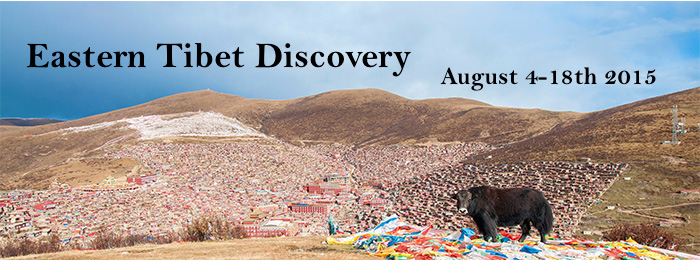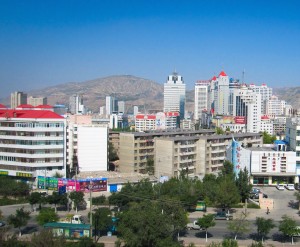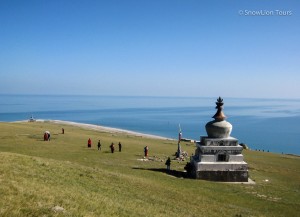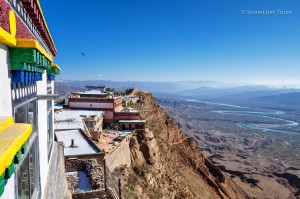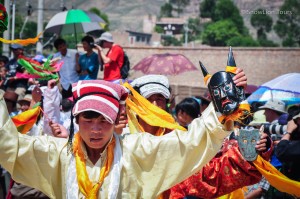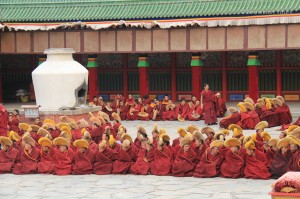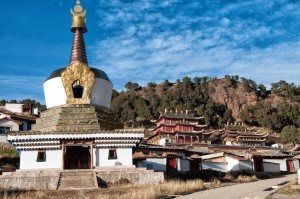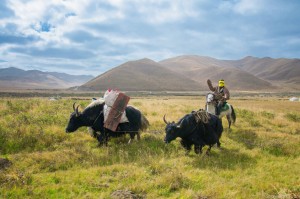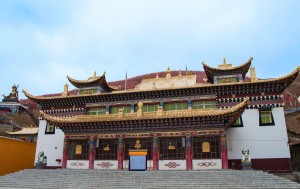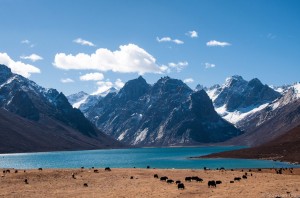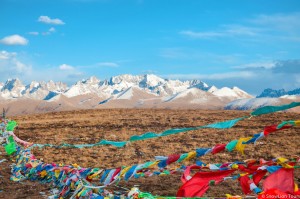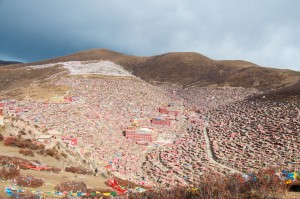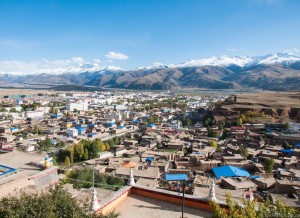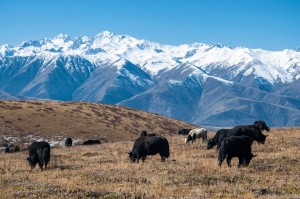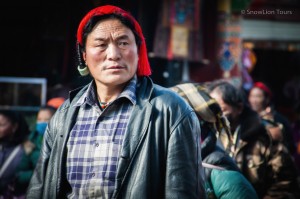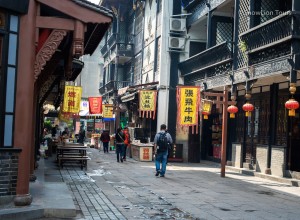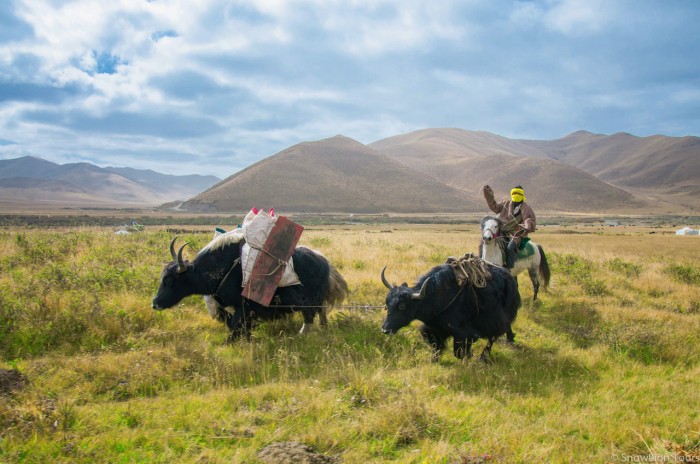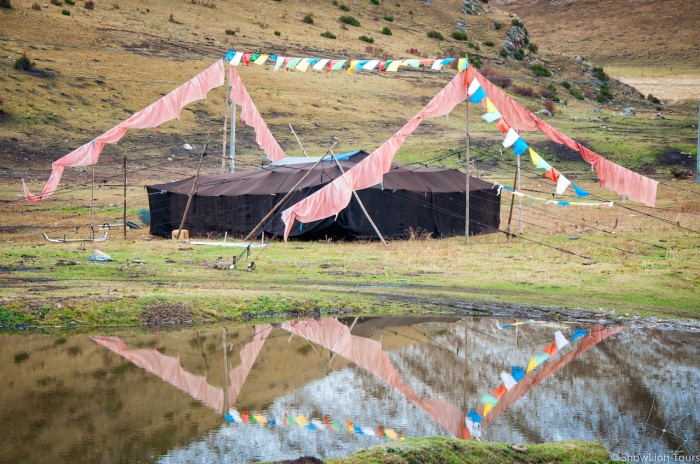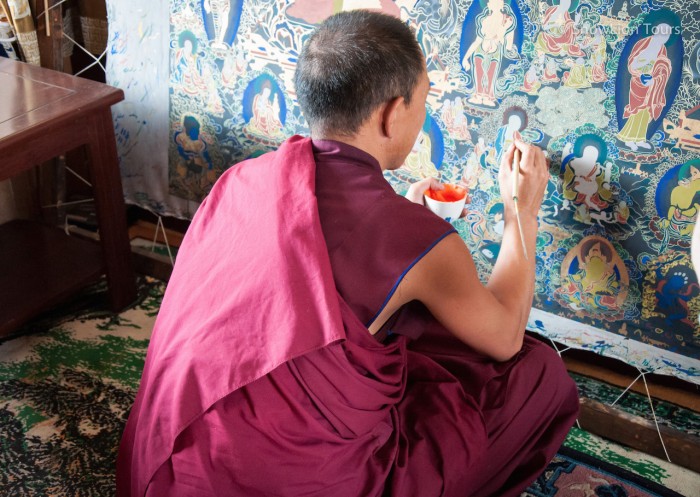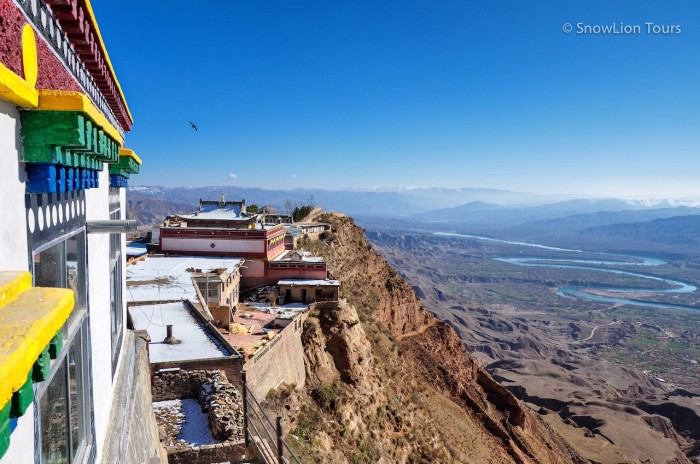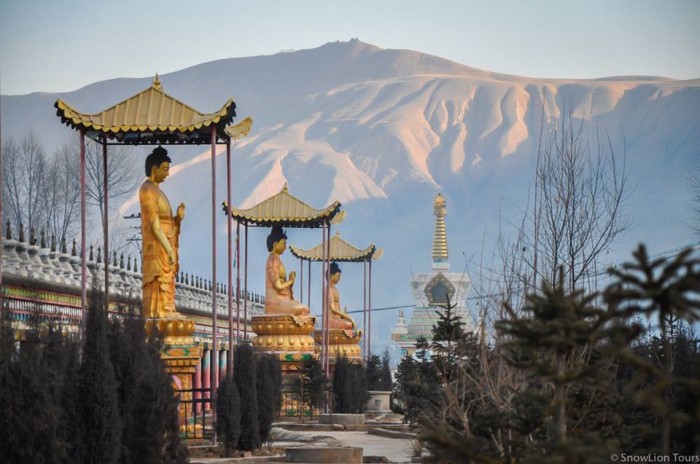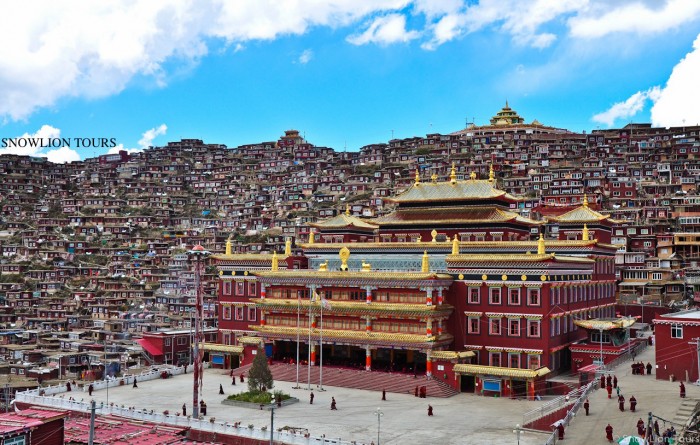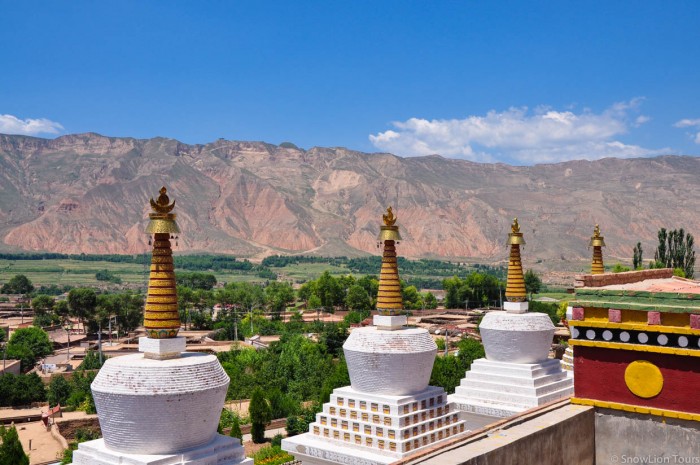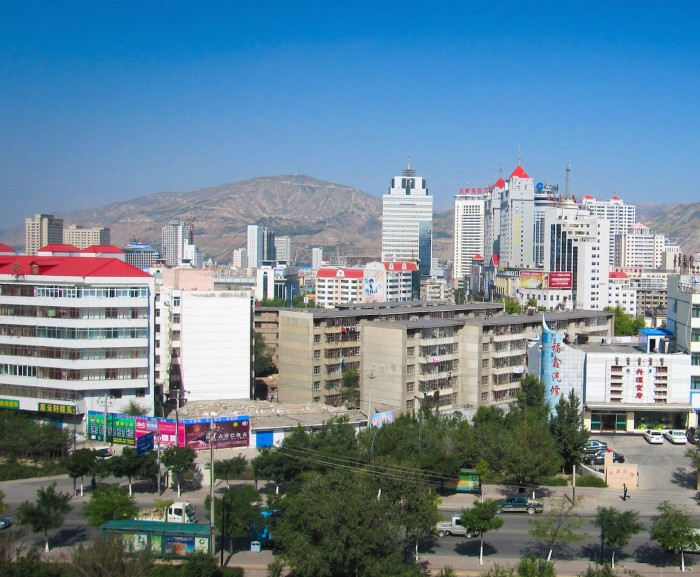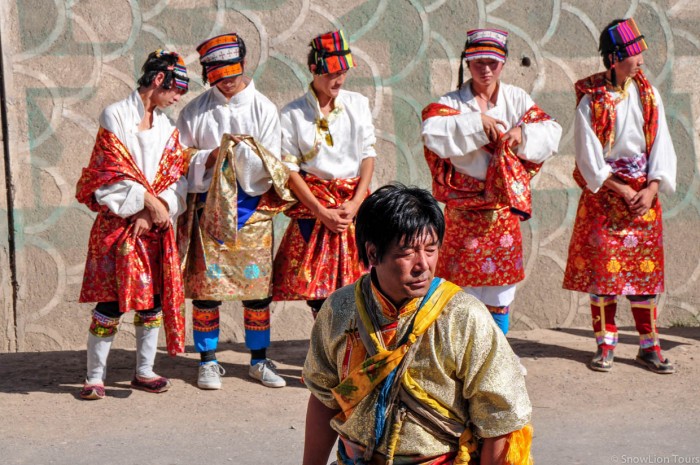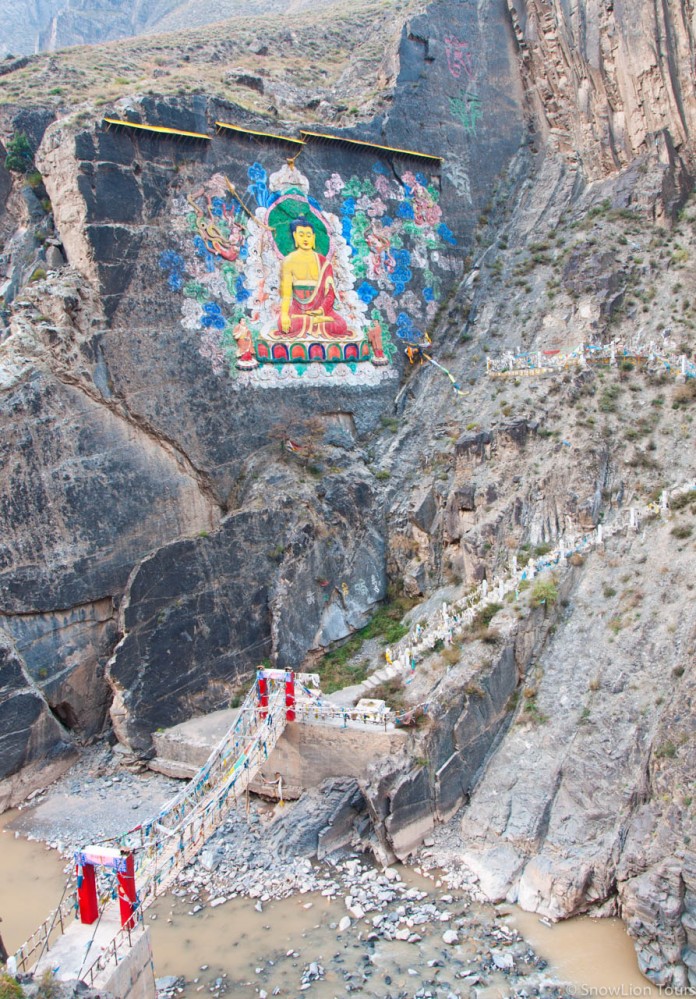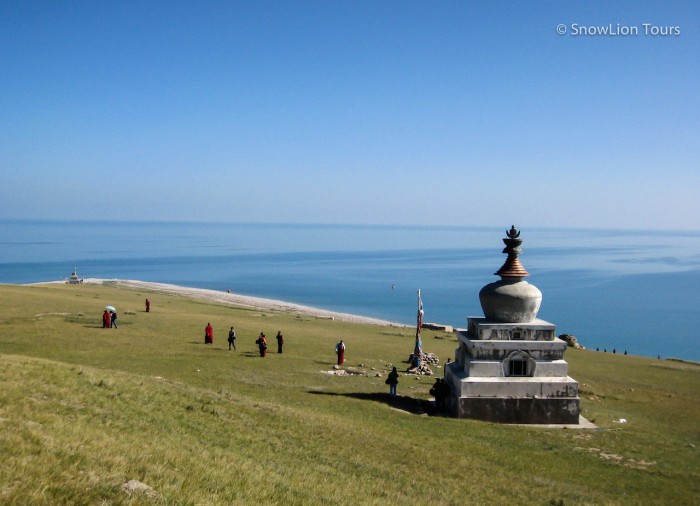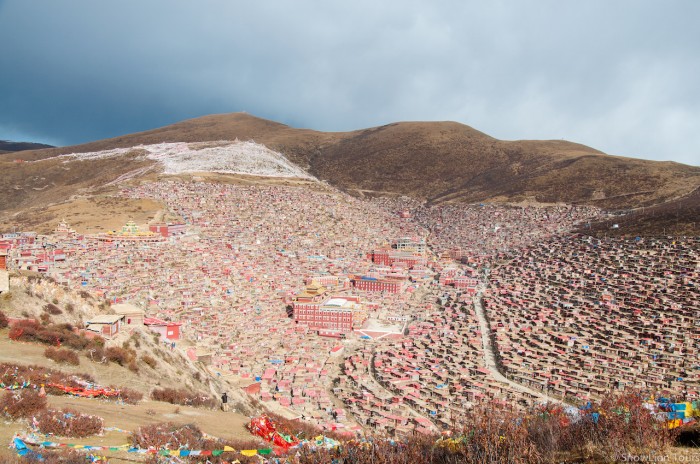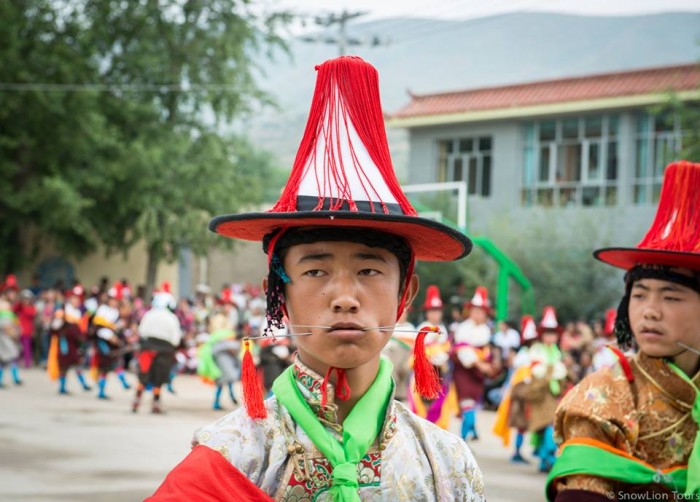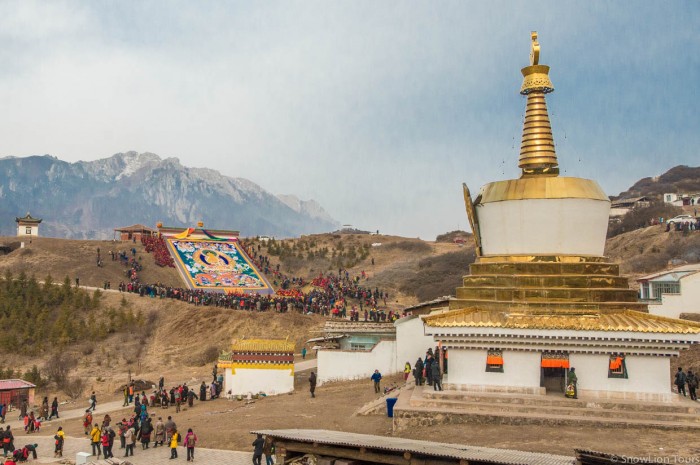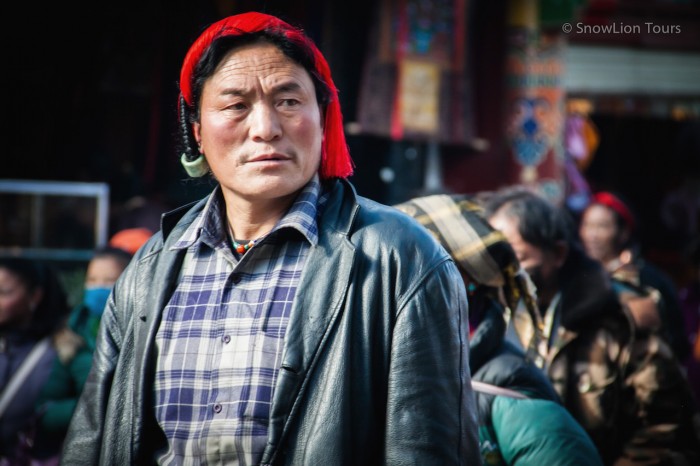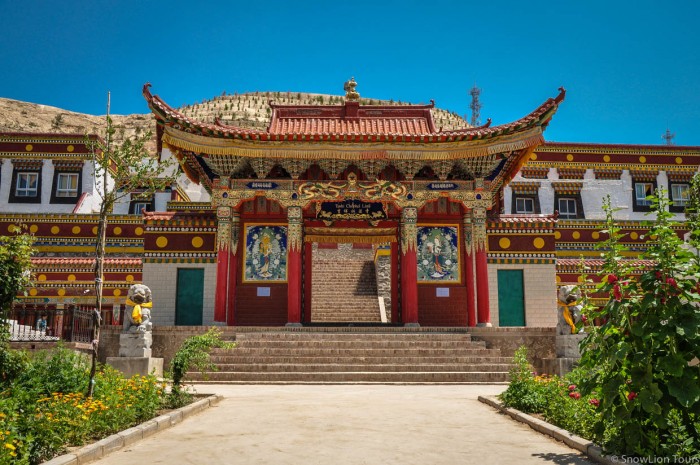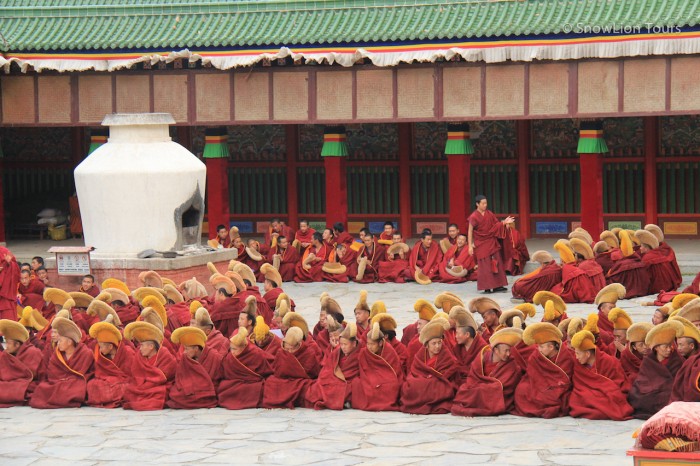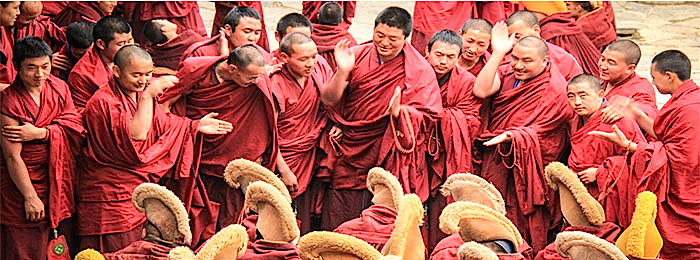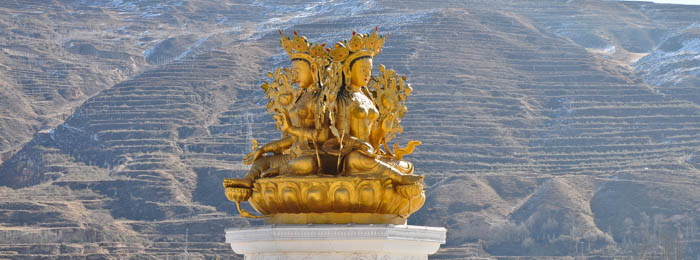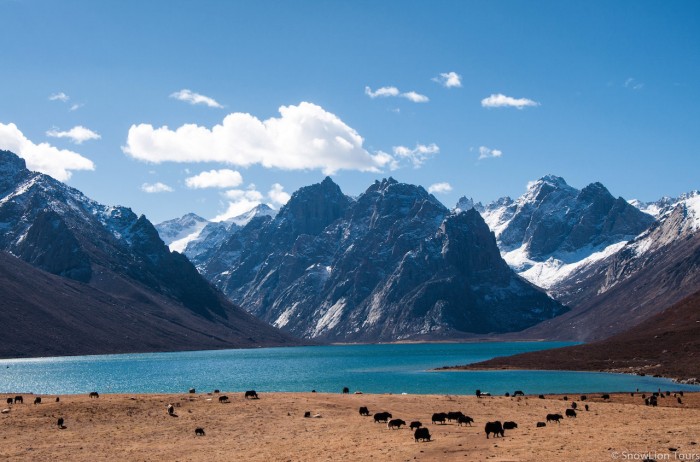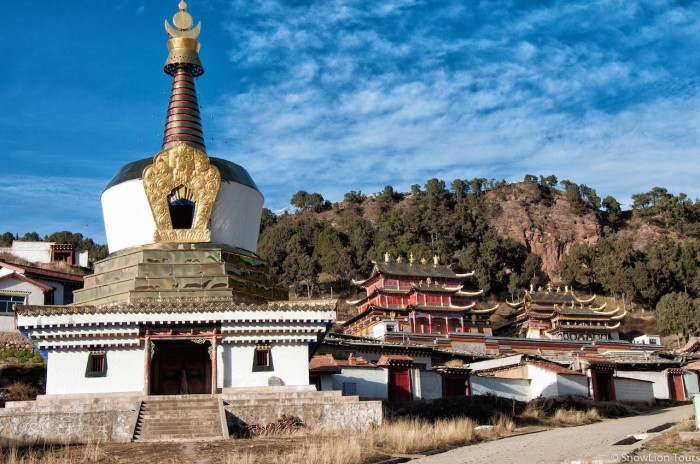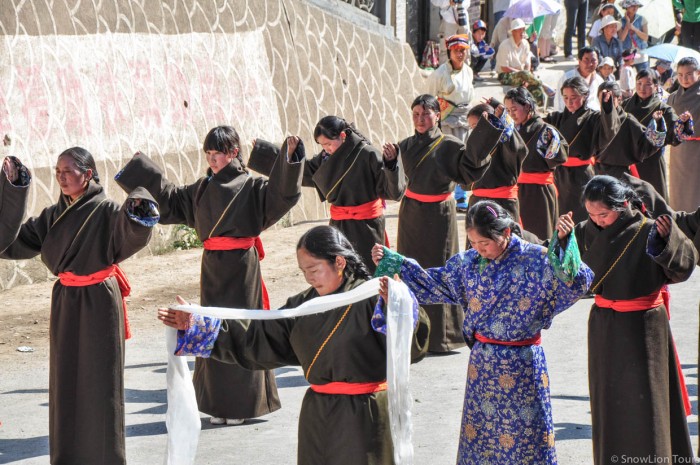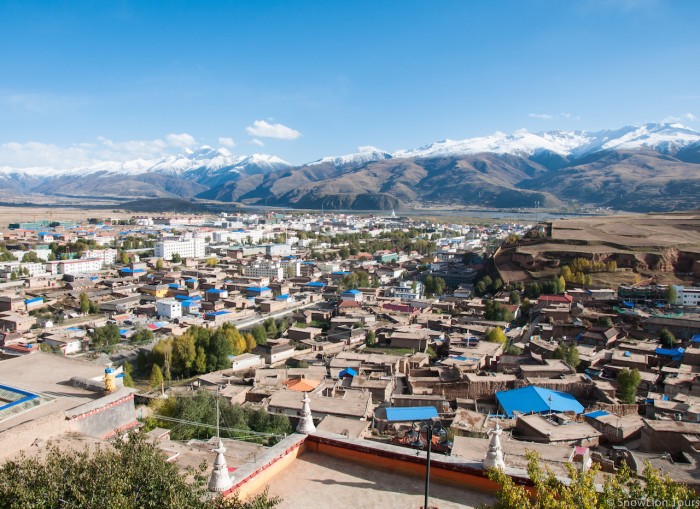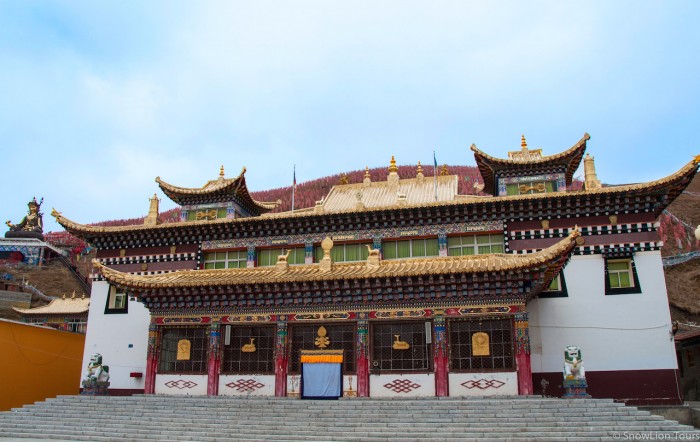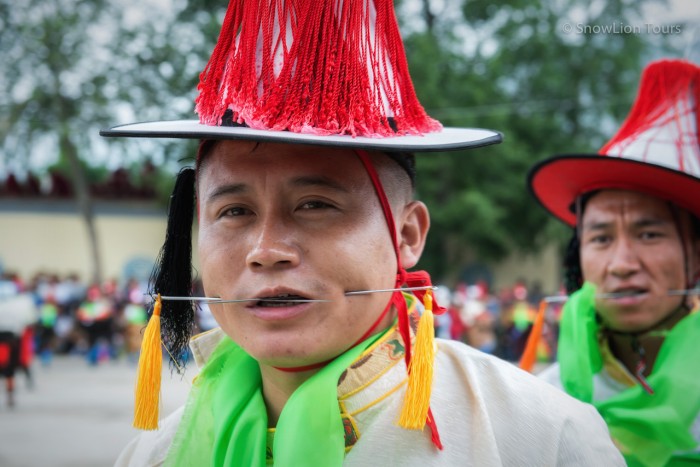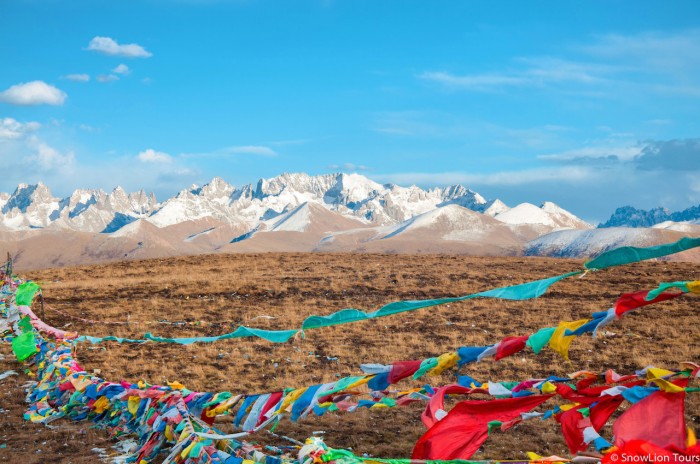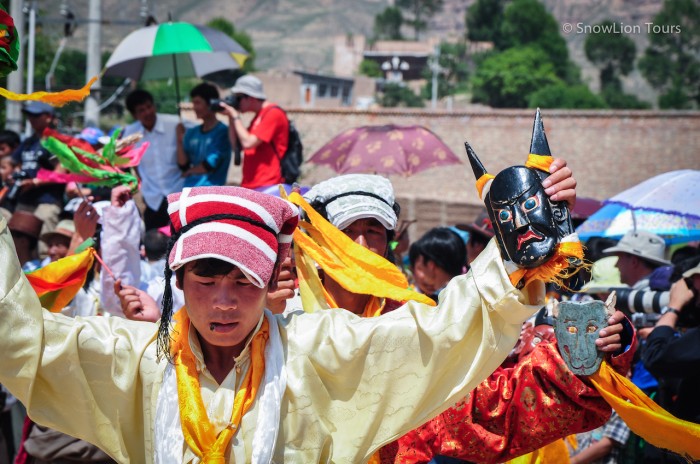Grand exploration of Amdo and Kham regions of Eastern Tibet
Join in the expedition to Eastern Tibet! This is a unique opportunity to explore all main sights of Amdo and Kham regions: holy mountains, glacier lakes, nomadic grasslands, Buddhist monasteries, and remote villages of Eastern Tibet within one journey!
Our expedition begins in Xining – the capital city of Qinghai province, also known as a border town between China and Eastern Tibet in the past. Drive to the Lake Kokonor – the biggest lake in Asia, explore basin of the Yellow River in Trika along with sacred Shachung monastery. Participate in the Shaman festival, which is annually held in a Bonpo villages in Rebkong. Drive to Labrang via nomadic Gangya grassland to explore the biggest monastery in Amdo. Experience real nomadic lifestyle in Taktsang Lhamo, and do a two day horseback trek throughout grasslands. Take great pictures of holy Mt. Nyenbo Yurtse and its glacier mountain lakes. Explore Larung Gar – the biggest Buddhist Institute of the Tibetan Plateau. Visit remote monasteries nestled in the sides of mountains and travel to the holiest and most beautiful snow mountains of Kham. At last, arrive in Chengdu – the capital city of Sichuan province and fly back home.
Highlights
- All highlights of Amdo and Kham
- Shaman festival
- Holy Mt. Nyenbo Yurtse, and Mt. Minyak Konka
- Larung Gar- biggest Buddhist institute
Details
- 15-day trip begins in Xining and ends in Chengdu
- 15 nights in hotels and guesthouses
- Altitude from 2200-4100+ m
Dates
- 04.08.2015 – 14.08.2015
04.08/Day 1: Arrive in Xining (2200 m) Amdo
Pick up at the Xining airport, transfer to your hotel and get settled. If time allows explore Xining on your own: hike up to Beishan mountain, where you can visit ancient Taoist temple, or go to the Tibetan Medical and Cultural Museum. In the afternoon group gets together in the Tibetan traditional restaurant. Here enjoy Tibetan cuisine, meet your guide and travel mates.
_____________________________________________________________________________
05.08/Day 2: Xining – Kumbum monastery (2700 m) – Kokonor lake (3270 m) – Trika (2200 m) Amdo
Drive to Kumbum monastery which is one of the six great monasteries of the Gelugpa school of Tibetan Buddhism. This monastery is also famous for being the birthplace of the great religious reformer Tsongkhapa. Afterwards drive to Kokonor lake (Qinghai Lake or Tso Ngonpo) – the largest lake in China. Take pictures of the blooming yellow flowers along the shores of the lake and visit the nomads herding yaks and sheep. In the afternoon drive to Trika (Chika or Guide) to catch stunning views of the Yellow River.
_____________________________________________________________________________
06.08/Day 3: Chika – Shachung monastery – Rebkong (2500 m) Amdo
In the morning visit Jokhang temple and drive to Shachung monastery – one of the most beautiful monasteries in Amdo, located atop of the hill from where you can see a stunning view of Yellow River. Afterwards, drive to Rebkong – art center of Tibet Buddhism. Here, visit four major monasteries – Rongwu, Gomar, Upper and Lower Sengeshung, Tibetan thangka galleries and artists’ villages.
_____________________________________________________________________________
07.08/Day 4: Shaman Festival in Rebkong
Take part in the annual shaman festival – a ceremony which honors the local mountain god and requests that he bestows good health on the villagers and a successful harvest on the community. One of the most important activities of the festival is a piercing one’s mouth or back side of a body. Shaman, on behalf of the mountain god, pierces a steel into back or cheek of participants. Participants continue performing circle dance with pierced cheeks until shaman pulls needles out and blows to the wound in order to heal it. This performance represents the blessing of mountain gods as well as good harvest.
_____________________________________________________________________________
08.08/Day 5: Rebkong – Gangya grassland – Labrang (2900 m) Amdo
Head to Labrang via the famous Ganjia grassland. Labrang, Amdo’s most famous monastery, is located in the small town of Xiahe. It is one of six great Gelugpa monasteries in Tibet, was found in 1709 by the First Jamyang Zhepa Ngawang Tsondru. Labrang sits at 2900m with high mountains and alpine forests surrounding it. It is a popular pilgrimage destination for Tibetans and is home to over 1700 monks.
_____________________________________________________________________________
09.08/Day 6: Labrang – Taktsang Lhamo (3300 m) Amdo
Travel from Labrang to the beautiful Tibetan town of Taktsang Lhamo (Langmusi). Taktsang means “Tigers Cave”, and Lhamo means “Goddess”. It is a township on the border of Sichuan and Gansu provinces. Here you will have chance to visit two major monasteries: Kirti Namgyal Dechenling and Sertang Monastery (locally called Lhamo gompa), both built in 18th century. Taktsang Lhamo is associated with Padmasambhava and Shridevi, and was frequently visited by yogis and meditation masters of the past. There is a gorge with several old meditation caves located in the area. Besides hermit caves and two monasteries, Taktsang Lhamo is famous for its sky burial site located atop of the hill. This is a sacred ground for the sky burial process.
_____________________________________________________________________________
10.08/Day 7: Taktsang Lhamo Horseback Trek Amdo
Taktsang Lhamo is a great place to do a short horseback trek to explore grasslands that are home to nomadic Tibetans. In the morning you will meet your nomadic crew who will teach you basic skills of horseback riding. Then you’ll start your trek across nomadic grasslands with amazing mountain scenery. Spend the night in a yak hair tent. It is unique opportunity to experience nomadic lifestyle, try locally made yak yogurt and milk tea, study how to graze yaks and catch horses by a ‘lasso’ rope.
_____________________________________________________________________________
11.08/Day 8: Taktsang Lhamo – Machu grassland – Jigdril (3800 m) Amdo
Come back to Taktsang Lhamo in the morning, meet your driver and continue to Jigdril via Machu grassland where you can see many Tibetan nomadic camps. Jigdril, also known as Jiuzhi in Chinese, is a county in Golog Tibetan Autonomous Prefecture in southeast Qinghai province and a part of Amdo region of the Tibetan Plateau. Here visit Tarthang monastery which was found in the 19th century by the 7th throne-holder of the great Nyingma monastery in Pelyul in Kham. Tarthang monastery belongs to Nyingma sect of Tibetan Buddhism, it quickly became the largest and most influential branch of Pelyul in the entire area with more than 1200 monks and 30 incarnated lamas.
_____________________________________________________________________________
12.08/Day 9: Jigdril – Mt. Nyenbo Yurtse – Padma (4100 m) Amdo
Drive to the west range of Mount Nyenpo Yurtse (5933 m) – holy mountain of southern Golok, which is considered as a birthplace of the nomadic Golok tribes. The mountain range has 14 peaks over 5000 meters. The steep snow-capped ridges of the mountain are surrounded by holy glacier lakes, such as Tsochen and Tsochung which steams flowing into the Yellow River, and lakes Tso Nagma and Nojin Tso which streams flowing into headwaters of Gyarong. The Nyenbo Yurtse Base Camp is located at 4000 meters, and climbing expeditions can also be organized. After enjoying holy mount scenery we’ll continue driving to Padma (Pema). This area is one of the most beautiful parts in Tibet. It lies south of the watershed range that divides the rolling grasslands of the Yellow River valley from the forested gorges of Gyarong. There are 23 monasteries scattered throughout the valleys of the county, 20 of which are Nyingma monasteries, and 3 are the monasteries of Kagyu and Jonang schools of Tibetan Buddhism.
_____________________________________________________________________________
13.08/Day 10: Padma – Serta (4000 m) Kham
Drive through nomadic grasslands surrounded by mountain ranges, stop for taking pictures and short hikes, breathing fresh mountain air. In the afternoon you’ll reach Serta (Sertal) county, which has a large number of monasteries representing only one school of Tibetan Buddhism – the Nyingma tradition. There are 31 Nyingma monasteries in the county. Here you will visit Larung Gar – largest Buddhist Institution on the Tibetan Plateau.
_____________________________________________________________________________
14.08/Day 11: Serta – Larung Gar
You will spend whole day exploring Larung Gar – Larung Five Sciences Buddhist Academy, which is housing thousands of students. This Nyingmapa institution was originally found by Dudjom Lingpa in the late 19th century, but its owes its recent revival to the khenpo Jigme Phuntsok, who was the spiritual teacher for thousands of Tibetan and Chinese monks, nuns and lay people. Nowadays thousands of ‘vow-holders’ as well as a some lay people are studying Buddhism here. The whole area of Larung Gar is divided into two parts: monks live on the right slope of the mountain, while nuns live on its left slope. Although Serta is located in Kham, it traditionally was a part of Golok prefecture in Amdo, a large percentage of the native people in this area speak Amdo dialect of Tibetan as their first language. There is a large number of incarnated lamas as well as ‘khenpos’ – holders of Bachelor’s degrees in Buddhism, live, teach and study in Larung Gar at the present time. The main building at Larung Gar are on the three levels: the lowest containing an assortment of small temples and concrete structures. The main assembly hall and the famous monastic college (shedra) of Larung Gar are at the mid-level, and the third level or the hilltop is dominated by two spectacular chapels: Tonpei Dekhang – containing a large Reclining Buddha, and the three-dimensional Gyutrul Lhakhang. Spend the night in the monastery guest houses located atop of the hill from where you can see the whole view of Larung Gar.
_____________________________________________________________________________
15.08/Day 12: Serta – Garze (3500 m) Kham
In the morning drive to the “Temple of Death” – a new temple which was constructed at the famous sky burial site about one kilometer north of the Larung Gar. Afterwards, drive to Ganzi, which is also known as Ganzi in Chinese or Kardze in Tibetan . Here you will visit Kardze monastery (Ganzin gompa) – one of the largest monasteries in Kham in the past. It was originally constructed by the Qosot Mongols in the middle of 17th century and had a population of 1500 monks. Nowadays it is housing more than 700 monks and several incarnated lamas.
_____________________________________________________________________________
16.08/Day 13: Ganze – holy Mt. Zhara Lhatse – Lhagang (3700 m) Kham
In the morning drive to Lhagang (Tagong) – a small town in Garze Tibetan Autonomous Prefecture in the Western Sichuan, Kham. The town is surrounded by Tagong grassland with the stunning view of the the sacred Mount Zhara Lhatse also known as Mt. Yala (5884 m). This mountain is also strongly connected with the stories of Guru Rinpoche (Padmasambhava). Lhagang is surrounded by five holy mountains which are Mt. Zhara Lhatse, Mt. Chenrezig, Mt. Jampeyang, Mt. Chana Dorje and Mt. Dolma. Due to it is surrounded by these holy mountains, the area is considered as special and blessed place. Here you will visit famous Lhagang monastery (Tagong gompa) and Nyingmapa Shedra.
_____________________________________________________________________________
17.08/Day 14: Tagong – holy Mt. Minyak Konka – Dartsedo (2600 m) Kham
Drive to Dartsedo (Dardo) which is also known as Kangding in Chinese – the capital town of Garnze Tibetan Autonomous Prefecture. Here you can see the stunning views of the holy Mount Minyak Konka or Mt. Minyak Gongga (Gongga Shan in Chinese). Its peak rises at 7556 m and – Asia’s highest summit east of the Himalayas. For Tibetans, Minyak Konka is the sacred abode of both Chenrezik and the Tantric deity Demchok. Along with Mt. Kailash, Mt. Amnye Machen and Mt. Kawa Karpo, it is one of the holiest mountains in Tibet and is a sacred pilgrimage site for many Tibetans. Dartsedo formerly had seven monasteries – two Gelug, two Sakya, and three Nyingmapa. Among these, you will visit the largest and most influential was the Gelug monastery Ngacho Gompa, which was found in the middle of 17th century. In the afternoon explore Dentok Ri Hill (Paomashan in Chinese), which overlooks the town and is considered as the sacred power place of the valley. Visit Dentok monastery located atop the mountain. You can take a cable car to reach this this monastery or you can hike up to it. If time allows visit Dordrak monastery, which has a numerous statues and images of Buddhist deities and meditation masters.
_____________________________________________________________________________
18.08/Day 15: Dartsedo – Chengdu. Kham
Drive to Chengdu – the capital city of Sichuan province. Your driver will drop you off at the hotel. Here enjoy local Sichuan food – one of the most famous Chinese cuisine, spend the night in a hotel or take a flight back home from Chengdu airport. End of the service.
_____________________________________________________________________
Itineraries are subject to change without prior notice.




